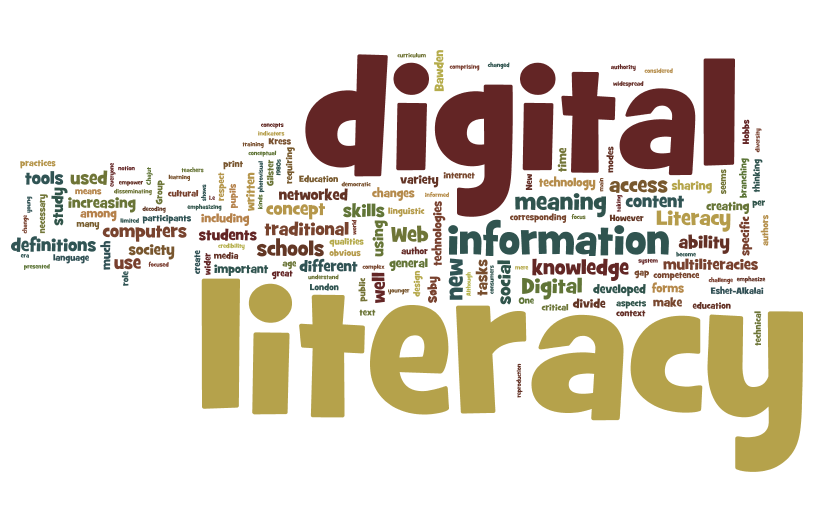Inadequacy of traditional definitions of literacy
In the 1980s, when personal computers became widespread used for word processing, the world of print and corresponding notion of literacy were seriously challenged. It seemed to be obvious that traditional definitions of literacy were inadequate. Richard Lanham in 1995 (p. 198) claimed that the traditional meaning of „literacy“ as “the ability to read and write” had transformed to new meaning as “the ability to understand information, however presented.” Nowadays in networked information economy maybe more than ever before it is obvious that new definitions of literacy are necessary. Jones-Kavalier and Flannigan (2006) recognized the necessity of a new literacy in our accelerated, media-saturated and automated society as a prerequisite for fully functioning members of society.
Since 1980s many new concepts of literacy have been developed, such as digital literacy, information literacy, media literacy, multiliteracies etc. These terms are not always clearly separated and sometimes are used interchangeably. This paper will focus on digital literacy because it seems to be a direct „translation“ of traditional literacy in the digital era.
What is digital literacy?
In the selected literature there is no consensus on what digital literacy is. Eshet-Alkalai (2004) identifies an extensive range of uses of a term “digital literacy” in the literature, from those focusing on technical aspects to those having cognitive, psychological, or sociological sense. However, many reviewed authors (Bawden, 2008, Buckingham, 2008, Eshet, 2002) emphasize that digital literacy is much more than mere addressing technical aspects, i.e. using computer programs. Eshet (2002, p. 2) wrote: „It [digital literacy] is a special kind of mindset; a special kind of or thinking.“
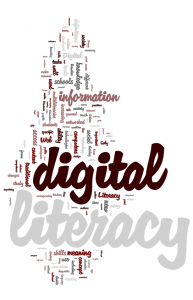 As suggested by Lankshear and Knobel (2008), there are conceptual definitions of “digital literacy” that present views of digital literacy as a general idea and more specific “standardized operational” definitions that describes digital literacy in terms of certain skills or competences considered as a standard for general adoption.
As suggested by Lankshear and Knobel (2008), there are conceptual definitions of “digital literacy” that present views of digital literacy as a general idea and more specific “standardized operational” definitions that describes digital literacy in terms of certain skills or competences considered as a standard for general adoption.
One of the conceptual definitions of “digital literacy” that it is applicable across the specific technologies including the context of social media, according to Bawden (2008), is provided by Paul Gilster. Bawden (2008) states that, although it had been used by many authors in the 1990s, the concept of digital literary was introduced exactly by Gilster in his book Digital Literacy in 1997. Gilster defined digital literacy as „the ability to understand and use information in multiple formats from a wide variety of sources when it is presented via computers“ (in Bawden, 2008, p. 19).
Renee Hobbs (2010) offers a “standardized operational” definition as a set of skills including: (a) finding and using digital tools and information, and sharing information with others; (b) comprehending information and analyzing messages in a variety of forms in respect to the author, purpose, point of view and credibility; (c) creating content in a variety of forms by means of language, images, sound, and digital tools and technologies, with consciousness of purpose, audience, and composition techniques; (d) reflecting on one’s own identity and communication behaviour with respect to social responsibility and ethical principles; (e) taking social action individually and collaboratively in order to share knowledge and solve problems in the family, workplace and community.
Diverse Modes of Representation
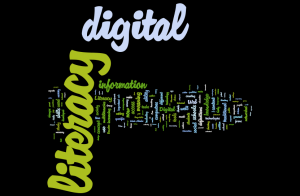 One of the crucial characteristics of digital literacy is using diverse modes of representation, as an opposition to press dominated by written text. Kress (2005) advocates multimodality with emphasis on image that has more and more been replacing writing. While speech and written text are organized in a temporal and sequential manner, image represents spatial organization of meaning. This change influences transformation in meaning of reading, which cannot be perceived mere as decoding, but as „reading as design“, meaning that readers design a coherent complex sign corresponding to their needs (Kress, 2005). The New London Group (1996) considers any semiotic activity, including using language to create or consume different kinds of text, a matter of design thus emphasizing active and dynamic nature of a meaning-making process.
One of the crucial characteristics of digital literacy is using diverse modes of representation, as an opposition to press dominated by written text. Kress (2005) advocates multimodality with emphasis on image that has more and more been replacing writing. While speech and written text are organized in a temporal and sequential manner, image represents spatial organization of meaning. This change influences transformation in meaning of reading, which cannot be perceived mere as decoding, but as „reading as design“, meaning that readers design a coherent complex sign corresponding to their needs (Kress, 2005). The New London Group (1996) considers any semiotic activity, including using language to create or consume different kinds of text, a matter of design thus emphasizing active and dynamic nature of a meaning-making process.
The New London Group (1996) argue that the multiplicity of communication channels as well as increasing cultural and linguistic diversity in the world today require shift from traditional language-based approach to literacy to much wider perspective. Their concept of multiliteracies transcends the limitations of traditional approaches to literacy by emphasizing linguistic and cultural differences as essential qualities of contemporary societies and private lives of students. The other critical aspect of multiliteracies is the increasing complexity and inter-relationship of different modes of meaning: linguistic, visual, audio, gestural, spatial, and multimodal. The latter represents an interconnection among the other modes of meaning. Cope & Kalantzis (2009) reworked the original model by separating written and oral language and adding tactile representation.
Social Dimension of Digital Literacy
The New London Group (1996, p. 4)) emphasize a social dimension of multiliteracies. „Mere literacy“ is focused usually on a „singular national form of languauge“, while multiliteracies addresses „the realities of increasing local diversity and global connectedness.“
However, some previous authors took a more complex approach to literacy, such as Scribner and Cole (1981, in Lankshear and Knobel, 2008, p. 5) arguing that literacy comprises “a set of socially organized practices which make use of a symbol system and a technology for producing and disseminating it”. That means that literacy is not just encoding and decoding different kinds of scripts, but applying this knowledge for specific purposes in specific contexts.
According to Cope & Kalantzis (2009) new literacy reflects changes in social and technological context such as new relationships in work place including collaboration and sharing, the developments of a civil society, and a „profound shift in the balance of agency“, which transforms workers, citizens and persons from spectators, audiences or passive consumers to players, creators and informed consumers.
In this new social context the notion of audience, author and authority has substantially changed. This phenomenon can be well described in one sentence written by Kress (2005, p. 19): „When everyone can be an author authority is severely challenged.“
These changes are part of a broader concept of democratic nature of digital literacy that allows the general public better access to information and knowledge as well as the ability to create and edit widely accessible content. Lanham (1995) suggests that digital literacy is profoundly democratic extending its scope from a ruling aristocracy to everyone. This is even more evident in the Web 2.0 era characterized by concepts of microcontent, openness and folksonomy, as referred to by Alexander (2006) that make creating, sharing and consuming digital content yet easier. Dobson and Willinsky (2009) remark that, even though digital literacy has a great potential for a much wider access to knowledge, it maintains historical continuity between print and digital literacy, with nineteenth-century public library and public school democratizing movements.
On the other hand, digital divide seems to remain a big challenge for achieving widespread digital literacy, no matter whether the source of divide is differences in access between developed and developing nations, income, gender, age, race or ethnicity.
Empirical Studies on Digital Literacy
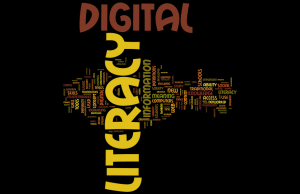 Statistics reports and empirical studies on digital literacy are scarce and since they are based on different understandings of digital literacy it is hard to validate and compare them.
Statistics reports and empirical studies on digital literacy are scarce and since they are based on different understandings of digital literacy it is hard to validate and compare them.
In the 2009 study Eshet-Alkalai and Chajut (2009) used a model of digital literacy that they developed comprising six skills: (a) photovisual literacy, (b) reproduction literacy, (c) branching literacy, (d) information literacy, (e) socioemotional literacy and (f ) real-time thinking skill. While all other skills seem self-explanatory, branching literacy requires explanation – “the ability to construct knowledge by a nonlinear navigation through knowledge domains” (Eshet-Alkalai and Chajut, 2009, p. 713). The study is focused on changes over time in digital literacy among 111 participants divided in three age groups: high schools students, college students and adults.
Findings reveal two main patterns of change over time: (a) narrowing the gap between younger and older participants in the tasks requiring photovisual and branching literacy and (b) widening the gap between younger and older participants in tasks requiring creativity and critical thinking, i.e. reproduction and information tasks. Comparison with the matched control groups clearly indicates that the experience with technology is the main factor responsible for the observed changes over time in digital literacy skills. This makes a promise for digital literacy to become a pillar of life-long learning.
As Søby (2008) noted, the report from The Norwegian Directorate for Education and Training The State of Equipment and Services in Education 2006–2007 shows the increase in networked computers availability. Over 90 per cent of all computers in schools were connected to the internet in 2007 in comparison with 80 per cent in 2005. A networked computer-pupil ratio ranges from 6.1 in primary schools to about 1.9 pupils per networked computer in upper secondary schools. However, Søby (2008) emphasizes that infrastructure and internet access does not guarantee corresponding use of digital tools in the curriculum. Søby (2008) discusses a longitudinal study on digital competence comprising 499 schools in Norway called ITU Monitor. The findings indicate that computers are used only to a limited extent as regards the type of tasks, involved subjects and time spent. Although there are considerable variations among different schools and pupils in the same grade, the majority of pupils make a limited use of computers, mostly for simple searches on the internet and tasks requiring use of Office programs.
One of the important goals of the study – to develop indicators that would operationalize the concept of digital literacy, resulted in the following indicators: to access, manage, integrate, evaluate and create using ICT. The study showed that teachers in general lay great stress on managing information while disregarding other aspects of digital literacy. Søby (2008) suggests that it is necessary to raise awareness among teachers about what digital literacy is.
Governmental and Institutional Support to Development of Digital Literacy
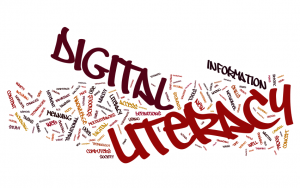 European Commission (2011) recognizes the importance of digital competence as being one of the key skills for life and employability. The question is not anymore if technology should be used in education, but rather how and where. Thus European Commission (2011) through a range of initiatives puts efforts in encouraging the pedagogical support, the learning opportunities and the assessment approaches that will promote the acquisition of digital competence.
European Commission (2011) recognizes the importance of digital competence as being one of the key skills for life and employability. The question is not anymore if technology should be used in education, but rather how and where. Thus European Commission (2011) through a range of initiatives puts efforts in encouraging the pedagogical support, the learning opportunities and the assessment approaches that will promote the acquisition of digital competence.
Selwyn (2009) argues that formal institutions such as schools and libraries have an important role in supporting young people’s engagement with digital technologies and digital information through providing young people with access to digital technologies, content and services, as well as additional training. The technical training should be accompanied with efforts to explore the ways in which “critical digital literacies” can be developed.
Digital Literacy and Education
Since digital literacy is considered to be a necessity for full participation in contemporary networked information society, it seems obvious that education system should take part in preparing students to become its informed members. Hobbs (2010) claims that introduction of media literacy in formal education can be an effort to bridge the digital divide and cultural gap, a way to empower students and make connections across subject areas, as well as means to foster e-inclusion.
Hobbs (2010, p. 31) identified five challenges that educators, curriculum developers and policymakers must consider before taking actions on digital literacy: (a) moving beyond a tool-oriented focus, (b) addressing risks associated with use of digital technology, (c) expanding the concept of literacy from print literacy to literacy as “the ability to share meaning through symbol systems in order to fully participate in society”, (d) increasing people’s capacity to assess message credibility and quality, and (e) bringing news and current events into classroom.
Digital Literacy in Informal Settings of Web 2.0
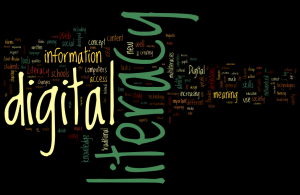 Although digital literacy as a broad concept can be maintained unchanged in the Web 2.0 age, concrete forms it takes in variety of tools, networks and practices of Web 2.0 have drastically changed with respect to the final result as well as process of creating, disseminating and communicating. For example, there is a huge difference between individual, close, completed qualities of a word document with collaborative, open and uncompleted qualities of a wiki page.
Although digital literacy as a broad concept can be maintained unchanged in the Web 2.0 age, concrete forms it takes in variety of tools, networks and practices of Web 2.0 have drastically changed with respect to the final result as well as process of creating, disseminating and communicating. For example, there is a huge difference between individual, close, completed qualities of a word document with collaborative, open and uncompleted qualities of a wiki page.
Through enabling easy and rapid creation, editing, sharing, remixing and other forms of manipulation with content, Web 2.0 tools represent a further step in democratization of digital literacy. Additionally, Web 2.0 movement empower users to play more important role not only in creating content but also in information architecture through contributing to a new form of metadata, the folksonomy (Alexander, 2006).
Conclusion
For further development of theory, research and practice it is necessary to gain a common understanding on what digital literacy is. In spite of digital divide that remains a serious challenge, digital literacy shows a great potential for a much wider access to knowledge. Developments in Web 2.0 tools and practices have an important role in increasing and democratizing digital literacy.
References
Alexander, B. (2006). Web 2.0: A new wave of innovation for teaching and learning? EDUCAUSE Review,41(2), 34-44.
Bawden, D. (2008). Origins and concepts of digital literacy. In Lankshear, C. and Knobel, M. (Eds.) Digital literacies: Concepts, policies and practices. (17-32). New York: Peter Lang.
Buckingham, D. (2008). Defining digital literacy. In Lankshear, C. and Knobel, M. (Eds.) Digital literacies: Concepts, policies and practices. (17-32). New York: Peter Lang.
Cope, B. and Kalantzis, M. (2009). ‘Multiliteracies’: New literacies, new learning. Pedagogies: An International Journal. 4(3), 164-195.
Dobson, T. and Willinsky, J. (2009). Digital literacy. The Cambridge handbook on literacy (pp. 1-30).
Eshet, Y. (2002). Digital literacy: A new terminology framework and its application to the design of meaningful technology-based learning environments. In P. Barker & S. Rebelsky (Eds.), Proceedings of World Conference on Educational Multimedia, Hypermedia and Telecommunications 2002 (pp. 493-498). Chesapeake, VA: AACE.
Eshet-Alkalai, Y. (2004). Digital literacy: A conceptual framework for survival skills in the digital era. Journal of Educational Multimedia and Hypermedia (1391), 93–106. Retrieved from http://www.openu.ac.il/Personal_sites/download/Digital-literacy2004-JEMH.pdf
Eshet-Alkalai, Y. and Chajut, E. (2009). Changes over time in digital literacy. CyberPsychology & Behavior, 12(6), 713-715. doi:10.1089/cpb.2008.0264
European Commission. (2011). Lifelong Learning Programme, General call for proposals 2011-2013, Strategic priorities 2012. Retrieved from http://ec.europa.eu/education/llp/doc/call12/prior_en.pdf
Hobbs, R. (2010). Digital and media literacy: A plan of action. Washington DC: The Aspen Institute.
Jones-Kavalier, B. and Flannigan, S. (2006). Connecting the digital dots: Literacy of the 21st century. EDUCAUSE Quarterly, 29 (2). Retrieved from http://net.educause.edu/ir/library/pdf/eqm0621.pdf
Kress, G. (2005). Gains and losses: New forms of texts, knowledge and learning. Computers and Composition, 22, 5-22.
Lanham, R.A. (1995). Digital literacy. Scientific American, 273(3), 198-199.
Lankshear, C. and Knobel, M. (2008). Introduction, Digital literacies: Concepts, policies and practices. In Lankshear, C. and Knobel, M. (Eds.) Digital literacies: Concepts, policies and practices. (1-16). New York: Peter Lang.
Selwyn, N. (2009). The digital native – myth and reality. Aslib Proceedings, 61 (4), 364 – 379.
Søby, M. (2008). Digital competence – from education policy to pedagogy: The norwegian context. In Lankshear, C. and Knobel, M. (Eds.) Digital literacies: Concepts, policies and practices. (119-149). New York: Peter Lang.
The New London Group. (1996). A pedagogy of multiliteracies: Designing social futures. Harvard Educational Review 66(1), 60-92.

